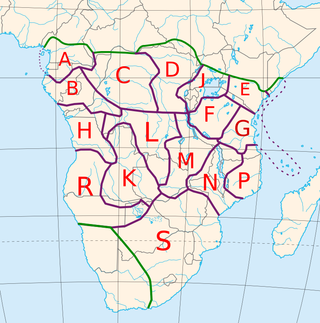Related Research Articles
Masaba (Lumasaaba), sometimes known as Gisu (Lugisu) after one of its dialects, is a Bantu language spoken by more than two million people in East Africa. The Gisu dialect in eastern Uganda is mutually intelligible with Bukusu, spoken by ethnic Luhya in western Kenya. Masaba is the local name of Mount Elgon and the name of the son of the ancestor of the Gisu tribe. Like other Bantu languages, Lumasaba nouns are divided into several sets of noun classes. These are similar to the genders in Germanic and Romance languages, except that instead of the usual two or three, there are around eighteen different noun classes. The language has a quite complex verb morphology.
Manyika is a Shona language largely spoken by the Manyika tribe in the eastern part of Zimbabwe and across the border in Mozambique. It includes dialects ChiBocha, ChiUngwe, and ChiManyika, from which the broad Manyika language gets its name.

Makhuwa is the primary Bantu language of northern Mozambique. It is spoken by four million Makua people, who live north of the Zambezi River, particularly in Nampula Province, which is virtually entirely ethnically Makua. It is the most widely spoken indigenous language of Mozambique.
Luhya is a Bantu language of western Kenya.

The Ovambo language is a dialect cluster spoken by the Ovambo people in southern Angola and northern Namibia, of which the written standards are Kwanyama and Ndonga.
The Nyanga language is a language spoken by the Nyanga people in Kivu province, north-eastern Democratic Republic of the Congo. Speaker estimates range from 27,000 to 150,000. Many of the Nyanga speak Congo Swahili, the dominant regional lingua franca, as a second language. Nyanga is a Bantu language. Most of the (scarce) linguistic research conducted on Nyanga has been based on the materials published by Biebuyck and Mateene.

The 250 or so "Narrow Bantu languages" are conventionally divided up into geographic zones first proposed by Malcolm Guthrie (1967–1971). These were assigned letters A–S and divided into decades ; individual languages were assigned unit numbers, and dialects further subdivided. This coding system has become the standard for identifying Bantu languages; it was a practical way to distinguish many ambiguously named languages before the introduction of ISO 639-3 coding, and it continues to be widely used. Only Guthrie's Zone S is (sometimes) considered to be a genealogical group. Since Guthrie's time a Zone J has been set up as another possible genealogical group bordering the Great Lakes.
Chopi,, is a Bantu language spoken along the southern coast of Mozambique.

Ngombe, or Lingombe, is a Bantu language spoken by about 150,000 people in the Democratic Republic of the Congo. In general, native speakers live on either side of the Congo river, and its many tributaries; more specifically, Équateur Province, Mongala District and in areas neighboring it. Ngombe is written in Latin script.
Mijikenda is a Bantu dialect cluster spoken along the coast of East Africa, mostly in Kenya, where there are 2.6 million speakers but also in Tanzania, where there are 166,000 speakers. The name Mijikenda means "the nine settlements" or "the nine communities" and refers to the multiple language communities that make up the group. An older, derogatory term for the group is Nyika which refers to the "dry and bushy country" along the coast.
Luyana (Luyaana), also known as Luyi, is a Bantu language spoken in Zambia and perhaps in small numbers in neighboring countries. It appears to be an divergent lineage of Bantu. It is spoken by the Luyana people, a subgroup of the Lozi people.
Oroko, also Bakundu-Balue or Balundu-Bima, is a poorly known Bantu dialect cluster spoken in Cameroon.
Zemba or Dhimba is a Bantu language spoken mainly in Angola where the language has about 18,000 speakers, and also in Namibia with some 7,000. It is closely related to Herero, and is often considered a dialect of that language, especially as the Zemba are ethnically Herero.
Samia (Saamia) is a Bantu language spoken by the Luhya people of Uganda and Kenya. Ethnologue includes Songa as a dialect, but it may be a separate language.
Buyu, or Buyi, is a Bantu language of Lake Tanganyika that is closely related to Nyanga.
Ikizu is a Bantu language spoken by the Ikizu peoples of Tanzania. Dialects are Ikizu proper and Sizaki. Maho (2009) treats Sizaki (Shashi) as a separate language. However, Ethnologue 16th edition retired the ISO code for Sizaki, merging it into Ikizu.
Losengo (Lusengo) is a Bantu language spoken in the Democratic Republic of the Congo. It has had a significant effect on Lingala, the most important Bantu language in the two Congos.
Leti, or Mangisa, is a Bantu language of Cameroon, spoken by the Mengisa people. Most Mengisa have switched to the Eton language, though a number of them continue to use Leti as a secret ritual language. A smaller number speak Leti as their mother tongue.
Doko is a Bantu language of the Democratic Republic of Congo. Ethnologue 16 classifies it as a dialect of Ngombe language, while Maho (2009) lists it as a separate, though perhaps unclassified, language.
Kwangwa (Kwanga) is a Bantu language of Zambia.
References
- 1 2 Nyanga-li at Ethnologue (18th ed., 2015) (subscription required)
- ↑ Jouni Filip Maho, 2009. New Updated Guthrie List Online